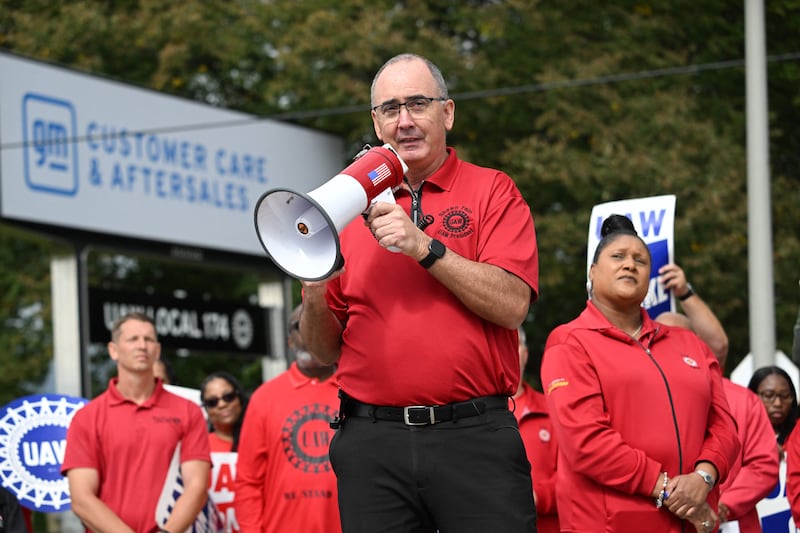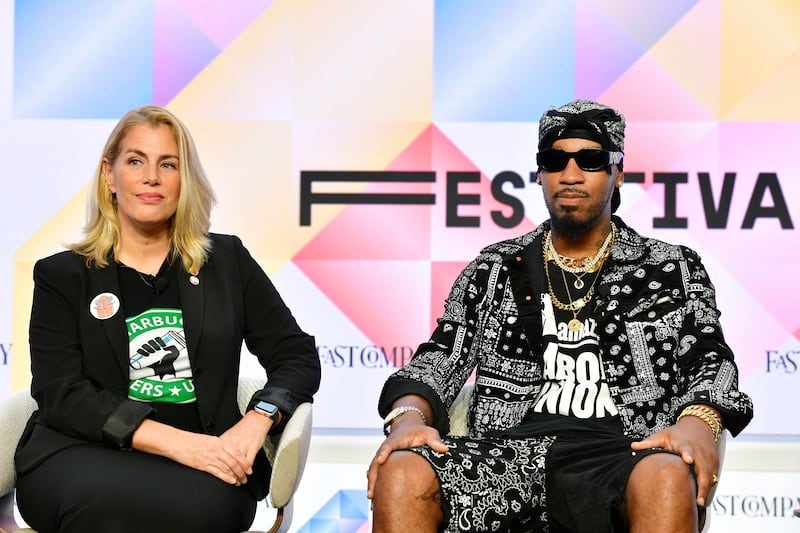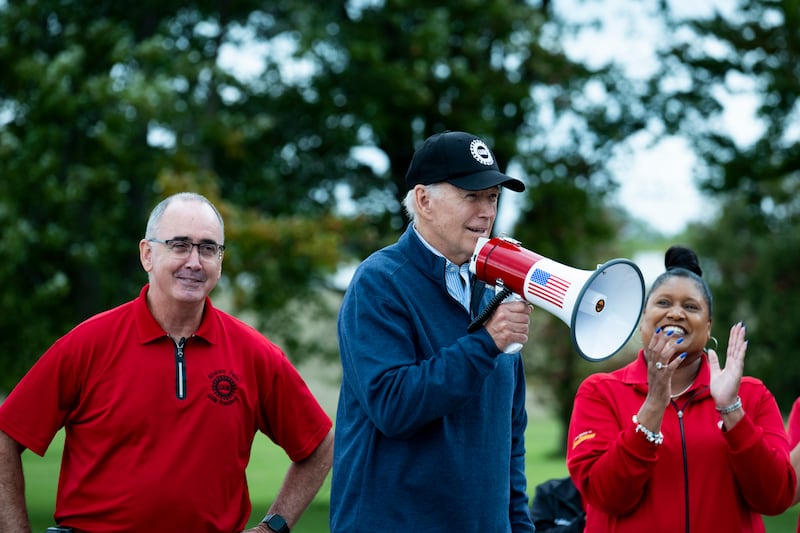In a community hall in northern Illinois last month, two presidents addressed a crowd of workers. One was Joe Biden, leader of the US. The other was Shawn Fain, head of the United Auto Workers (UAW). It was the union chief who appeared to receive the warmer welcome.
On this November afternoon, they were celebrating a victory. A year earlier, carmaker Stellantis had announced it was closing the assembly plant in Belvidere, laying off 1,200 workers who make the Jeep Cherokee. The move was like “getting hit in the solar plexus”, says Ron Byers, a 29-year veteran of the manufacturer. “You’ve done everything the company had asked for, and then they go and pull the rug out from under you.” But the union fought back. During a six-week strike against the big three carmakers, Ford, General Motors and Stellantis, the UAW successfully bargained to reopen the plant.
Not only that, but Stellantis agreed to invest $4.8 billion (about €4.4 billion) to retool and launch a new midsize pick-up truck there, create a “megahub” for parts distribution, and potentially build a second assembly plant and battery factory. “The UAW brought the hammer and said, ‘You want to build cars? You’re going to build cars in Belvidere also,’” Byers says.
These tactics not only reopened the Belvidere plant, they yielded contracts raising wages for autoworkers at the three carmakers by 25 per cent.
READ MORE
The contracts are “game-changers, not only for UAW workers, but for all workers in America”, Biden told the crowd. “You’re changing the face of the country economically.”
The UAW plans to use its wins at the bargaining table to recruit more union members. It has announced a sweeping effort to organise workers at the US plants of more than a dozen non-unionised carmakers, including Tesla, Toyota and Volkswagen.

The union is simultaneously tapping into and feeding a rising assertiveness in the US labour movement, which has seen union membership dwindle for two generations.
The aspirations extend beyond the auto industry. Fain speaks about declining welfare among working people broadly. The union has used its strike against the carmakers to highlight fights in other industries, from healthcare to gambling to airlines.
The UAW is encouraging unions across the US, in every sector, to time their contract expiration dates to the UAW’s; in the US, most union contracts contain clauses that allow workers to strike only when the contract expires. By telling other unions to line up their contract expiration dates with the UAW’s, the autoworkers’ union is trying to lay the groundwork for sweeping industrial action that could extend beyond the auto industry.
“We’ve talked a lot about saving the American dream,” Fain told the crowd in Belvidere. “For 40 years, our country has been going backwards. The working class keeps getting left behind, while the billionaires strip our communities for parts. And there’s only one thing that can stop that. It’s us. It’s the working class, united in common cause.”
Nurses, baristas, graduate students, actors and screenwriters all walked off the job in the US this year, many citing a desire to preserve middle-class lifestyles that have been squeezed by persistent inflation.
[ US actors’ strike ended after securing ‘deal-breaker’ AI agreementOpens in new window ]
More than 485,000 US workers went on strike in 2023 as unions launched an estimated 317 work stoppages, more than any time in the past two decades, according to an analysis by Bloomberg Law. Labour economists at Cornell University estimate that 310,000 workers were on strike in October alone.
There remain many obstacles to this new wave of activism, given that labour law in the US can make it harder for unions to organise than in most other advanced economies.
Union leaders could also overplay their hand. Industries like cars are facing dramatic technological changes that could reduce the number of workers needed – a shift that could speed up if wages soar. And if inflation persists in the coming months, unions will get some of the political blame, though they represent a fraction of the US workforce.
But, for the first time in years, labour advocates see a chance to grow union membership rather than simply fight rearguard actions against decline.
They believe this is partly the result of discontent about inequality in a country where corporate profits have soared, while median household income adjusted for inflation has fallen nearly 5 per cent in the past four years.
The pandemic also shifted attitudes. Economists and organisers say the Covid-19 crisis showed many workers how little power they had to negotiate with their bosses over pay and working conditions. So when a post-pandemic labour shortage suddenly gave workers more leverage, union members were emboldened to take direct action, including walking off the job.
“People learned during the pandemic that they needed a stronger voice in their workplace,” says Stuart Appelbaum, president of the Retail, Wholesale and Department Store Union. “People also see income inequality has continued to increase, and they know something needs to be done about it.”
Momentum had already been building when the UAW went on strike, he says, with organising in new industries and the Teamsters union winning a lucrative new contract for United Parcel Service workers in July. Those gains suggest “the tide has already begun to turn”, he says.
Car manufacturing holds a particular place in the American imagination. The industry is a critical component of the nation’s industrial base, employing about a million people when including parts suppliers, and contributing 3 per cent towards gross domestic product. In the minds of many Americans, “autoworker” remains shorthand for the proverbial “good job”.
The UAW played an important role in that process. In the 1930s, the nascent industry paid meagre wages until workers in Flint, Michigan, sat down in a General Motors factory and refused to leave for 44 days, winning pay rises and inspiring strikes in other industries.
According to Bob Bruno, a labour professor at the University of Illinois Urbana-Champaign, the sit-down strike was an important moment in creating the conditions for middle-class prosperity in the US, including higher incomes, better benefits and job security. Under president Walter Reuther, who led the UAW from 1946 until his death in 1970, the union pushed the US government towards greater social welfare policies.
“The UAW is just an iconic labour union,” Bruno says. “They were at the heart of the emerging American middle class, the great postwar economic boom, the politics of labour liberalism, the New Deal and the Great Society… So what happens to the autoworkers is seen as significant to the ability of the labour movement to deliver on the American dream.”
However, along with the rest of the labour movement, the UAW has seen its membership decline. Changes in the economy that took root in the 1980s, including rising global trade and a relative decline in manufacturing, reduced the space for unions. In 1981, then president Ronald Reagan fired striking air traffic controllers in a decisive pushback against union power.
Critics blamed the UAW and the contracts it managed to secure for helping to make the big three carmakers less competitive – which they say eventually contributed to GM and Chrysler declaring bankruptcy in 2009. Production in the US car industry shifted in part to states in the south where unions have a weaker legacy.
In 1954, one in three US workers belonged to a union. Now it is one in 10. The UAW claims 400,000 members in a range of industries, a quarter of the peak of 1.5 million in 1979.
[ Joe Biden joining a picket line was a landmark moment in US’s year of strikesOpens in new window ]
Just under 150,000 of those members work at one of the traditional big three carmakers. With the launch of its massive organising drive, it is seeking to unionise about the same number.
Fain is one of several union leaders who is taking a different approach to the past, a group that includes the Teamsters’ Sean O’Brien, Sara Nelson at the Association of Flight Attendants and the organisers of the US teachers who have gone on strike in the past decade. Their rhetoric is not focused solely on union members, but calls out economic inequality more broadly.

Fain ran for the UAW presidency as a reform candidate after a corruption scandal paved the way for members to directly elect their president for the first time in the union’s 88-year history.
Elected with only a few hundred votes to spare, Fain brought an adversarial stance and an unprecedented level of transparency to the bargaining process. He rejected a traditional media photo-op with the executives at the big three carmakers before bargaining started, and he livestreamed weekly addresses on Facebook to update members on progress at the bargaining table, or lack thereof.
“Shawn Fain does represent a different kind of union leader that is more exciting to workers and is willing to fight in a way that maybe we haven’t seen in some time,” says Beth Gutelius, research director at the Center for Urban Economic Development at the University of Illinois Chicago. “To the extent that there’s other union leadership like that, that could change the tides.”
[ Biden’s backing of striking US car workers could come back to bite himOpens in new window ]
The union’s victory has already spilled over to non-union carmakers, several of whom raised wages in an effort to stave off unionisation at their own plants.
Autoworkers’ victory in the strike “transcends the contracts they were negotiating”, Appelbaum says. His Retail, Wholesale and Department Store Union is running campaigns to organise outdoors retailer REI, bookseller Barnes & Noble and Amazon.
The UAW argued during its campaign that workers throughout the US, not just in the auto industry, were at the losing end of a class war. Those arguments resonated with the public, Appelbaum says, and the autoworkers’ success “encourages people everywhere to stand up and demand what they deserve”.
The larger labour movement is trying to build on the momentum of the UAW, Teamsters and organising at companies such as Amazon and Starbucks. The American Federation of Labour and Congress of Industrial Organizations is the largest umbrella group in the US labour movement, with 60 affiliated unions representing more than 12 million members.
Christian Sweeney, the group’s deputy organising director, says it is working to ensure workers have technical tools, such as software designed for organising, and it is running training sessions to boost organising capacity. “Organising begets organising,” Sweeney says. “When one employer organises, it’s viral.”
“I’ve been organising since the late 1990s,” he adds. “It’s way, way, way better than it has been in the last 20-plus years.”
Public opinion has been shifting in the direction of organised labour. Approval of labour unions in the US has been rising for more than a decade, peaking at 71 per cent last year before dropping to 67 per cent in 2023, according to polling company Gallup.
[ Trade unions cannot focus just on pay and conditions, Mick Lynch tells Cork eventOpens in new window ]
However, capitalising on the momentum will be difficult as US labour law has shifted against organised labour. Unions complain that companies can interfere in efforts to organise by holding mandatory meetings for employees where they can claim that unions will lead to layoffs or other catastrophic results. They say employers can also fire union leaders with no penalty except being forced to reinstate them with back pay if they lose an administrative hearing, which can make it a worthwhile proposition to try.
At the state level, 26 out of 50 states have passed right-to-work legislation, which states workers cannot be forced to join a union – and pay the associated dues – to get or keep a job. Until five years ago, non-members still had to pay a fee to public sector unions, even if they did not join the union, because the union still had to represent them.
But, in 2018, the US supreme court overturned a 41-year-old precedent requiring that fee from non-members working in the public sector anywhere in the country. The public sector is more heavily unionised in the US than the private sector.
Growing the percentage of unionised workers in the US will take an “enormous groundswell from ordinary people”, says Christopher Hayes, a labour historian at Rutgers University.
“That’s a lot of stars to line up,” he says. “Can it happen over time? I hope so.”
The aggressiveness of the UAW’s stance in the run-up to the strike put Biden in a tricky political position, especially at a time when he was being blamed by Republicans for high levels of inflation.
The president had called himself “the most pro-union president” in US history and had made appointments to the National Labour Relations Board that were friendly to workers. But the UAW withheld its endorsement of him, a seal of approval that comes with campaign cash and foot soldiers to help get out the vote on election day.
Michigan and Ohio both have heavy concentrations of carworkers and are both critical battlegrounds in the presidential election. Though Ohio has voted Republican four times in the last six presidential elections, Michigan has largely voted Democratic, then broke for Trump in 2016 before choosing Biden four years later.
While presidents often have tried to stay out of labour disputes, the union’s strategy ultimately forced Biden to pick a side. In October, he became the first sitting US president to walk a picket line. The union has continued to withhold its endorsement in the 2024 presidential election, saying it must be earned.

At the rally in Belvidere, the president reminded the crowd he had visited the picket line and that his presumed Republican opponent, former president Donald Trump, had visited a non-union manufacturer.
There are also risks for the UAW in its more confrontational approach. The car industry is in the early stages of a dramatic transition to electric vehicles, which require far fewer components and potentially fewer workers. Carmakers are pushing for the batteries to be built with non-union labour, a position that would slowly bleed the union of members.
Tonya Glover waited in a line that stretched down the block to hear Fain and Biden speak. She approved of how Fain had handled the strike: “He fought for us.”
The deal does too little to benefit retirees and eliminate wage scales, she says, but she planned to vote in favour of it after hearing Fain describe how this contract creates a pathway for more wins in the future.
“I love the fact that all three went out at the same time,” she says. “You got to start somewhere, so this is a start. Next contract, we might be out here again.” – Copyright The Financial Times Limited 2023
- Sign up for push alerts and have the best news, analysis and comment delivered directly to your phone
- Find The Irish Times on WhatsApp and stay up to date
- Our In The News podcast is now published daily - Find the latest episode here

















